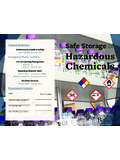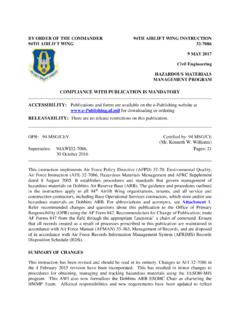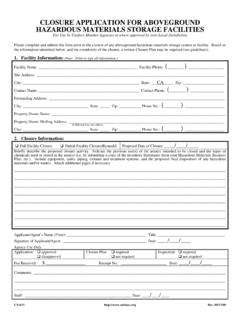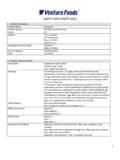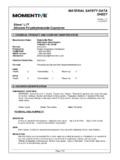Transcription of Environment, Health & Safety Hazardous
1 General Assistance Environment, Health & Safety Safe Storage of Hazardous business hours (510) 642-3073. Emergency Phone Numbers Chemicals Life-threatening Emergencies land line 911. cell phone (510) 642-3333. Hazardous Material Spills business hours (510) 642-3073 EH&S. off-hours & weekends (510) 642-6760 UCPD. Facilities Services 24 hour contact (510) 642-3073. Department Contacts Name Phone Number Department Safety Coordinator Building Coordinator Lab or Shop Emergency Contact Office of Environment, Health & Safety Contents Page Introduction 1. Take Inventory of Your Chemicals 1. Label Your Chemicals 2.
2 Segregate Incompatibles 5. Common Incompatibles 7. Basic Storage Requirements 9. Chemical Storage Guide: Individual Hazards and Mixed Hazards 11. Flammables and Combustibles 14. Corrosives 17. Toxics 19. Highly Toxics 20. Oxidizers 22. Compressed Gases 24. Cryogens 26. Pyrophorics (Air Reactives) 28. Water Reactives 29. Explosive and Potentially Explosive 30. Peroxide Forming Chemicals 34. 1. Introduction The safe storage of Hazardous chemicals is an essential part of an environmental, Health , and Safety program. Chemical storage facilities must meet certain minimum standards to satisfy diverse regulations, such as those of Cal/OSHA, the local sanitary district, and the California Fire Code.
3 This manual provides guidelines to help you meet these standards. In addition, laboratories and work areas on campus must observe several requirements that incorporate safe storage: Keeping an up-to-date chemical inventory Maintaining a chemical hygiene plan and documenting staff training Conducting annual self-inspections EH&S provides more information on the above programs at its website The five sections of this brochure cover the main elements of a safe chemical storage program: Section Information 1 How to Maintain an Accurate Inventory of Hazardous Chemicals 2 Proper Chemical Labeling Illustrations by Oruc Cakmakli 3 Segregating Incompatible Chemicals 4 Providing Basic Storage Needs 5 Storing Chemicals according to their Hazardous Characteristic 2 3.
4 Take Inventory of Your Chemicals Label Your Chemicals Safe storage begins with an up-to-date inventory of Hazardous All Hazardous chemicals must be clearly labeled for the chemicals that can be used to apprise personnel of the dangers benefit of current users, emergency personnel, and future in a laboratory, shop, or work area. An accurate inventory users. Unknown chemicals can be expensive to dispose of. is also necessary if emergency responders are to respond Make sure all labels are legible and in good condition. Repair effectively to a fire or chemical release in the area. The campus or replace damaged or missing labels.
5 Can be fined if it does not provide an inventory to emergency response personnel and appropriate regulatory agencies. Manufacturers' Labels Cal/OSHA requires that manufacturers provide labels with The Office of Environment, Health & Safety (EH&S) the following information: coordinates the collection of chemical inventories for the campus. Submit your inventory to EH&S annually. Also contents of the container submit one whenever the maximum amount listed for a physical and Health hazard information particular chemical changes by more than 50 percent or name, address, and emergency phone number of the you obtain a chemical that was previously not reported.
6 Manufacturer or other responsible party Immediately notify EH&S if a laboratory or other area has been cleaned out or a new laboratory has started up or moved. Original manufacturers' labels must not be removed or defaced. Material Safety Data Sheets (MSDSs) must be The annual review of your chemical inventory is a prime accessible to anyone working with these chemicals. Electronic opportunity to clean out unwanted chemicals. Your unwanted format MSDSs are available from the EH&S web site at http://. chemicals will either be picked up and disposed of or collected for reuse through the campus Chemical Exchange Program The MSDS may also provide useful storage information.
7 (CHEX). Visit the EH&S web site ( ) for Fact Sheets about CHEX and disposal of unwanted Hazardous materials. Your Own Labels Hazardous chemicals that are not in the manufacturer's original container ( , working solutions prepared in the lab) must, at a minimum, be labeled with the contents of the container. If the contents are Hazardous , attach a label indicating the hazard to warn individuals in the work area. It is not necessary to label containers that will be used temporarily (during one work shift) and are under your immediate control. Keep an extra copy of your inventory handy at a central location.
8 Label your chemicals. 4 5. Segregate Incompatibles classes. Incompatible chemicals within the same hazard class should also be separated from one another. For example, both nitric and perchloric acids are incompatible with organic acids Chemical Families (such as acetic acid) and should not be stored together. Materials should always be segregated and stored according to their chemical family or hazard classification. Do not store Most labs have limited space, but the following priorities may chemicals alphabetically unless they are compatible! The most help you decide how to store the chemicals.
9 Common hazard classes include: Do not store chemicals alphabetically unless they are flammables/combustibles compatible. corrosive acids Store flammable liquids in approved Safety containers in corrosive bases flammable storage cabinets. Do not store anything but toxics flammable or combustible liquids in these cabinets. highly toxics Segregate acids from bases. oxidizers Segregate most organic acids from oxidizing mineral acids. compressed gases Keep oxidizers away from other chemicals, especially cryogens flammables, combustibles, and toxic materials. pyrophorics Keep corrosives away from substances that they may react water reactives with and release corrosive, toxic, or flammable vapors.
10 Explosives Multiple Hazard Classes Accidental contact between incompatible chemicals can result Many chemicals belong to more than one chemical family or in a fire, an explosion, the formation of highly toxic and/or hazard class. In such cases, all storage rules must be strictly flammable substances, or other potentially harmful reactions: observed. For example, acetic acid is both a corrosive acid and a combustible liquid. It must be stored away from corrosive Oxidizers mixed with flammable solvents can cause a bases, such as sodium hydroxide, and also from oxidizing acids, fire. Acids mixed with metal dust can produce flammable such as nitric acid.
